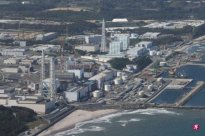
In addition to the production of nuclear sewage and nuclear pollution soil in Fukushima First Nuclear Power Station in Japan, a bunch of buildings left around the nuclear power plant left after removal of high -core substances covered by concentration.Japanese media broke the news that the supervision nuclear ruins of the Ministry of Environment of Japan were not in place. Some construction workers secretly sold scrap iron covering nuclear substances while the metal price was good.
According to the exclusive report of the daily news, the Daxiong Town near the Fukushima first nuclear power plant measured a high concentration nuclear material due to nuclear accidents.In 2017, Japanese officials began to remove the buildings in this region, including two buildings of libraries and folk museums that allowed construction companies to be highly polluted by nuclear pollution.
In accordance with the special measures of radioactive pollution treatment formulated by the Ministry of Environmental Ministry of Environment, the dismantling building waste materials must be collected at the specified temporary storage location by exceeding 100,000 Beclerels per kilogram.If it is below 100 Becler, it can be reused.However, this needs to be measured within the temporary storage location to determine whether it is lower than the standard.
Workers and workers can earn nearly one million yen in seven times in two months
Daily news quoted anonymous buildings in the building industry, saying that from April to June this year, many workers did not remove the demolished scrap iron and scrap copper threads from the demolition site when clearing the ruins in Daxiongchi.To the storage land, it was sold to a company in Fukushima Prefecture.For such trading, they did seven times in total, with a paid of 900,000 yen (about S $ 8,300).
It is reported that these Japanese workers have seen money, because after the crown disease epidemic is eased, the price of construction materials in Japan has risen, and the price of scrap iron and scrap copper is currently twice as much as 2019.
The contractor who was also responsible for demolition in Dakangcho believed that this happened because of the omissions of the site supervision.There are no resident supervisors on the construction site. The staff of the Ministry of Environment just come to check occasionally. Monitoring is limited. It is too easy to take away things without authorization. Workers can do whatever they want.
For the leakage of nuclear waste materials, the Japanese environmental departments refused to respond to the inquiry. The response they gave was: "The main inherited contractor Kashima is investigating and notified to the police."
The concentration of the demolition site is higher than the target
Since 2017, the Japanese government has been demolished for the Fukushima nuclear pollution area each year. The budget that was allocated last year was 220 billion yen.
According to daily journalists observed at the scene, as of the beginning of September, the construction continued, and the demolition site was filled with various metal fragments.The nuclear concentration measurement station set on the spot is currently 0.632 Micro-sievert per hour, which is 0.23 Micrius per hour higher than Japan's long-term target that reduces radiation by removing radiation.
In general, people will also be exposed to radiation when receiving medical examinations.According to the information, the radiation volume of dental X -ray is 5 microcosiopus; the radiation volume received by long -distance cross -ocean flights is 80 Micheva.Once the human body is exposed to the amount of radiation of 100,000 microeifaifu, blood cells will change significantly.




